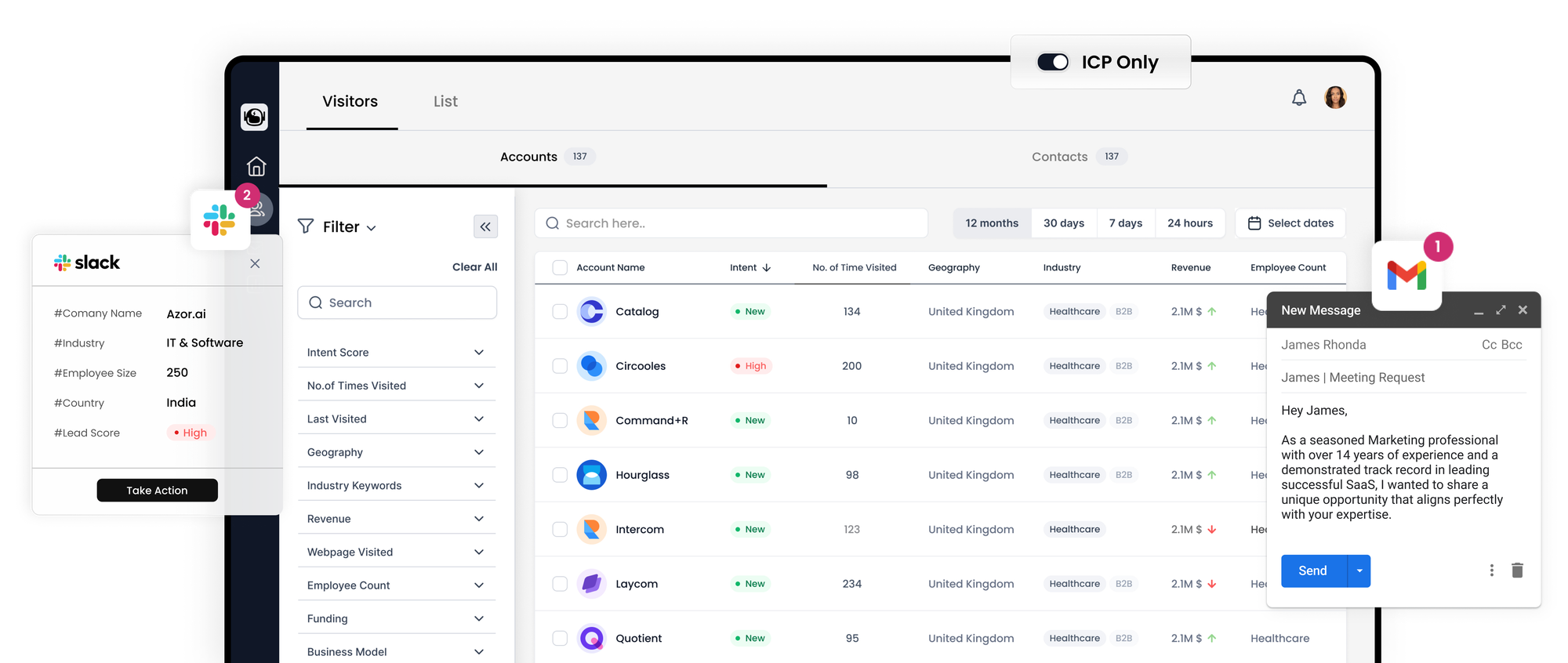Exploring Demand Generation: Frequently Asked Questions (FAQs)

Demand generation is a multifaceted concept encompassing various marketing programs aimed at igniting customer interest in your company's products and services, all without a direct sales pitch. This approach seeks to create excitement around your offerings, expand into new markets, showcase new product features, generate public relations buzz, and re-engage existing customers.
In essence, demand generation is a long-term, education-focused marketing strategy that prioritizes reaching and engaging potential buyers who may not currently be in an active buying cycle. The primary objective of B2B demand generation is to establish and maintain top-of-mind awareness, ensuring that when the need arises, your product or service is the immediate consideration for purchase.
What sets demand generation apart from other customer acquisition tactics is its commitment to nurturing long-term customer relationships and its strategic outlook.

How does demand generation differ from lead generation?
Demand generation and lead generation may seem similar, but they have distinct objectives and methods:
Demand Generation: This marketing strategy is all about educating your audience without expecting anything in return. It focuses on building awareness, interest, and trust among potential customers over the long term.
Lead Generation: In contrast, lead generation is primarily concerned with capturing contact information from prospects. It often involves more direct efforts to identify potential customers and push them into sales automation workflows.
What are the common challenges faced by lead generation strategies?
Lead generation strategies can encounter several obstacles that hamper their effectiveness. Here are six common reasons behind the struggles of lead generation efforts:
1. Misalignment with the Modern Buyer's Journey: Research from Gartner indicates that B2B buyers spend only 17% of their time engaging with sales. Despite this, many lead generation efforts focus on pushing prospects into sales conversations prematurely.
2. Impact on Sales Team Morale: Generating large volumes of uninterested leads can demoralize sales development representatives (SDRs) who are exposed to leads that are not in a buying cycle.
3. Sales-Marketing Conflict: Often, lead generation efforts lead to conflicts between sales and marketing teams. The classic dispute of "marketing is sending us low-quality leads" versus "sales can't close deals" can result in inefficiencies.
4. Brand Perception among Research-Stage Buyers: Gating content and aggressively pursuing leads can damage your brand's perception among research-stage buyers who may eventually be interested in your offerings when the timing is right.
5. Gated Content Challenges: Content gating, which requires users to fill out forms to access content, often collects the contact information of uninterested buyers (Marketing Qualified Leads or MQLs). This can result in an influx of leads that aren't genuinely interested.
6. Over-Reliance on Lead Scoring and Nurturing: Relying too heavily on lead scoring and nurturing assumes that marketing can predict the right sales triggers based on behavioral data and intent signals.
Is gated content a suitable lead generation tool for demand generation?
Gated content has both advantages and disadvantages when used in the context of demand generation. Here are some key considerations:
Drawbacks of Gated Content:
1. Limited Page Views and Traffic: Gated content tends to receive fewer page views and traffic compared to freely accessible content.
2. No SEO Benefit: Gated content doesn't contribute to search engine optimization (SEO) efforts or improve your website's visibility.
3. Deters Users: Requiring users to fill out forms can deter them from downloading the content.
4. Limited Brand Visibility: Gated content may restrict brand visibility, as it may not be as widely shared or accessible.
However, if you choose to use gated content within demand generation, it's essential to do so strategically. Gated content should primarily serve as a tool for Account-Based Marketing (ABM) warm-up rather than direct-response sales follow-up. This approach ensures that the content aligns with your demand generation objectives.
The Significance of Inbound Marketing in B2B Demand Generation
In the realm of B2B demand generation, inbound marketing plays a pivotal role. However, it has evolved beyond the traditional notions of content calendars and the AIDA framework. Today, it centers around aligning with sales to effectively respond to a buyer's intent to make a purchase (often referred to as declared intent), all while orchestrating and facilitating the desired purchasing experience.
In the context of inbound marketing today, there are essentially two primary approaches: demand capturing and demand creation. Let's delve into what each of these means.
1. Demand Capturing:
Demand capturing involves leveraging intent channels and content strategies to capture the interest of potential buyers who are already expressing an intent to purchase. Here are some examples of demand capturing tactics and the types of content associated with them:
Intent Channels
These include avenues like email marketing services, best ETL (Extract, Transform, Load) tools, identity protection companies, ERP (Enterprise Resource Planning) integration tools, and more.
Verticalized Demand Capture
This approach targets specific industries or niches, such as CRM (Customer Relationship Management) for real estate, SEO (Search Engine Optimization) for startups, QA (Quality Assurance) metrics for software testing, VoIP for enterprise, and so on.
SEO
Employing SEO as a bottom-of-the-funnel demand generation strategy. This entails creating blogs and landing pages optimized for keywords that indicate purchase intent.
PPC (Pay-Per-Click)
Bidding on keywords with commercial intent to attract your target audience as they narrow down their solution options.
CRO (Conversion Rate Optimization)
Optimizing conversion rates through testing programs aimed at increasing conversions among high-intent website visitors.
Review Websites
Platforms like G2, TrustRadius, and Gartner, where buyer personas seek in-depth peer reviews and ratings of brands, products, and services.
Affiliates & Aggregators
Utilizing websites like PCMag, US News, Business.com, and TechRadar to reach a broader audience.
Intent Data Providers
Leveraging services like Bombora, 6Sense, and DemandBase to gain insights into the intent of potential buyers.
2. Demand Creation:
Demand creation, on the other hand, involves using education channels and various content types to educate and engage potential buyers. Here are examples of channels and content types associated with demand creation:
Social Media Platforms
Platforms like LinkedIn, Twitter, Facebook, and TikTok serve as avenues for creating brand awareness and launching products through influencers in your industry.
Influencer Marketing
Collaborating with relevant influencers within your niche to raise brand awareness or promote new product launches.
Email Marketing
Utilizing email campaigns for newsletters, content promotions, nurture sequences, and event invitations.
Online Communities
Engaging with communities such as The Hustle, Sales Hacker, and Demand Curve to connect with your target audience.
Offline Media
Exploring offline advertising methods like direct mail and subway ads in locations like NYC.
Offsite Channels
Contributing guest posts, participating in press releases, and establishing thought leadership in your industry.
Audio Channels
Leveraging platforms like podcasts, interviews, and radio advertising to disseminate information and engage with the audience.
Video
Utilizing video content on platforms such as YouTube, LinkedIn, Vimeo, Wistia, and Loom to deliver educational content and engage viewers.
Events
Hosting webinars, live hangouts, and virtual conferences to interact with potential customers and provide valuable insights.
Conferences
Participating in industry-specific events like INBOUND, SaaStr, and Dreamforce to connect with key players in your field.
Forums
Engaging with online forums such as Reddit, Quora, Slack, and Discord to participate in discussions and address queries related to your industry.
The Role of Sales in B2B Demand Generation
The landscape of demand generation has undergone significant changes in recent years. Previously, it was often perceived as marketers adopting the role of salespeople, employing lead generation tactics driven by marketing automation. However, this perception has evolved as B2B executives recognized that marketing should be a strategic partner rather than a mere order-taker.
Today, outbound-focused demand generation differs significantly from high-volume cold outreach with automated follow-up sequences. Instead, it revolves around Account-Based Marketing (ABM) and an inverted marketing funnel.
ABM is a bottom-up marketing strategy that collaborates closely with the sales team to engage with high-quality leads and target accounts during complex B2B sales cycles. This approach emphasizes a full-funnel marketing approach, combining elements of inbound, outbound, and lifecycle marketing to create a well-rounded and high-performing demand generation program.
Metrics and Key Performance Indicators (KPIs) for Assessing Success
In the realm of demand generation marketing, the ultimate guiding principle should be the quality of leads. In addition to grasping essential SaaS (Software as a Service) metrics, it's crucial to pose some critical questions to evaluate your strategy effectively:
1. **Identifying High-Quality Lead Channels**: Which channels are responsible for driving highly qualified leads to your business?
2. **Lead Conversion Analysis**: Among different lead types, which ones most frequently convert into qualified sales pipeline opportunities?
3. **Opportunity Conversion Rate**: What percentage of your opportunities eventually translate into paying customers?
4. **Customer Retention**: How many of your paying customers stay with your business long enough to become profitable?
5. **Effective Marketing Channels**: Among your marketing channels, which ones are generating opportunities with the highest Lifetime Value (LTV)?
6. **Enhancing Qualified Opportunities**: How can you generate more qualified opportunities from the most effective channels?
7. **Full-Funnel Visibility**: How can you ensure visibility across the entire sales pipeline, from the top of the funnel to conversion?
8. **Sales Accountability**: What strategies can be implemented to hold the sales team accountable for handling leads appropriately?
9. **Marketing-Sales Feedback Loop**: How can you establish an effective feedback loop between the marketing and sales departments to improve collaboration?
Leading Indicators - Exemplary Metrics:
1. **Brand Search Volume**: The volume of searches related to your brand.
2. **Brand vs. Competitor Brand Search Volume**: A comparison of your brand's search volume with that of your competitors.
3. **Organic Traffic to High-Intent Website Pages**: The amount of organic traffic directed to web pages with high purchase intent.
4. **Direct Traffic**: The number of visitors who directly type your website's URL into their browsers.
5. **Entrances and Engagement on Feature/Solutions Pages**: Metrics related to user entrances and engagement on pages showcasing your product features or solutions.
6. **Referral Traffic**: The traffic originating from other relevant websites and social platforms.
Lagging Indicators - Exemplary Metrics:
1. **Assisted Conversions**: The number of conversions facilitated by pages that users interacted with on their path to a final conversion.
2. **Website Traffic to Conversion Rate (Declared Intent)**: The conversion rate of website visitors who have explicitly indicated their intent to make a purchase.
3. **Qualified Demo to Sales Opportunity Rate**: The rate at which qualified product demonstrations lead to potential sales opportunities.
4. **Proposal Sent to Closed/Won Rate**: The rate at which proposals sent to potential clients result in closed and won deals.
5. **Average Deal Size**: The average monetary value of your business deals.
6. **Sales Pipeline Velocity**: The speed at which deals progress through your sales pipeline.
7. **Cost Per Acquisition (CPA)**: The cost incurred to acquire each new customer.
8. **Customer Lifetime Value (CLV)**: The total value a customer brings to your business over their entire relationship with you.
What is the difference between Declared Intent & Assumed Intent?
The landscape of digital marketing has evolved from a focus solely on direct response and lead generation campaigns to a more comprehensive approach encompassing brand awareness, demand nurturing, and demand capturing throughout the entire sales funnel.
In this context, it's essential to differentiate between declared intent and assumed intent when considering the calls-to-action (CTA) on your website. A "declared intent audit" can reveal whether assumed intent leads are being treated as declared intent. Such misalignment between sales experience and buyer expectations needs correction.
Understanding your customers and their needs is paramount in this approach. By anticipating marketing trends and leveraging marketing automation software, you can enhance personalization, run A/B tests, choose suitable content, and customize timing for each marketing campaign and customer segment.
Initiating your demand generation strategy necessitates getting acquainted with your customers through qualitative research, including user feedback and conversations. If you encounter difficulties in comprehending your prospects' needs, don't hesitate to engage with them directly. Successful demand generation hinges on your ability to connect effectively with your target customers, and a solid starting point is imperative.
